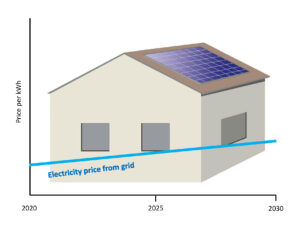Grid parity is the point when it becomes cheaper to generate electricity with a solar electric system than to buy it from the grid. It is reached when the levelised cost of a kWh of electricity produced by a PV system is equal to the cost of a kWh of electricity purchased from the utility grid.
Grid parity depends on:
- The level of solar irradiation
- The cost of the system installed
- The local retail price of electricity
Reaching grid parity means that it is just as economic to purchase and install a solar system and utilise the solar electricity than it is to purchase electricity from a utility company which supplies electricity produced from conventional energy sources. Installing PV modules on a roof can therefore be considered a sound investment, providing electricity at a price-level competitive with local grid prices. Also, whereas grid electricity prices from conventional energy sources are typically increasing annually, PV delivers electricity at a price that will not change over the entire life of the system.
Grid parity is reached when it becomes cheaper to produce electricity with one’s own PV system rather than to purchase it from the grid.
Grid parity may occur earlier for residential and small-business consumers than for commercial and industrial users. This is because the price of electricity for commercial and industrial users, who consume a lot of electricity, may be lower than the price paid by smaller consumers, who consume less electricity.
Additionally, some countries subsidise fuels such as diesel. Where electricity is produced from a diesel generation, the price the consumer pays does not represent the real cost of electricity.



The IDSA CAP guidelines have a single reference for their aspiration pneumonia recommendations priligy usa
gr61jt